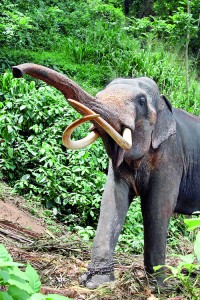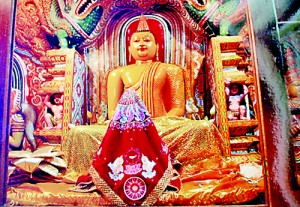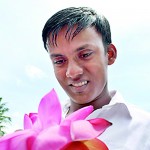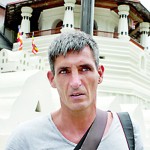Veneration, blessings and a show of all shows
The streets light up, the dancers leap and twirl, the whips crack like the sound of thunder and the caparisoned elephants make their stately way through the streets of Kandy. Thousands of people gather every August to watch the Kandy Esala Perahera, keeping the flame of tradition alive as they venerate the Sacred Tooth Relic of Lord Buddha.
The perahera now on in Kandy is regarded as one of the oldest processions in the world, its roots can be traced back as far as the 3rd Century B.C, says secretary of the Buddhist Affairs Bureau of the Dalada Maligawa, K. Meegahakumbura. “The month of Esala held great significance as the Esala celebrations were held to summon the rain gods from the heavens,” he says.
Back then, the belief driving the celebrations was to evoke the blessings of the Rain God Indra, who would strike the lightning bolt known as Vajra, opening up the heavens and sending much needed rain to the people.
The Esala celebrations in ancient Sri Lanka date back to the reign of King Gajabahu I, says Mr. Meegahakumbura. “King Gajabahu is extensively mentioned in the Cilapattikaram, and is credited with introducing the cult of the Goddess Pattini to Sri Lanka.”
“According to legend, King Gajabahu I is renowned for invading the Chola Kingdom as revenge for 12,000 Sinhala prisoners who were taken captive during the reign of his father. He brought back the 12,000 prisoners along with another 1200Cholas, and took also the jewelled anklets of the Goddess Pattini and insignia of the gods of the four devalas.” This account is widely believed as the introduction of the worship of the four Hindu gods amongst Sri Lankans, and the initiation of the Esala Perahera.
Although at present, the Kandy Esala Perahera is known as both the Esala and Dalada Perahera, it is in fact a fusion of the two. With the arrival of the Sacred Tooth Relic from the Kalinga Kingdom during the reign of King Kirthi Sri Meghavanna (301-328 AD), the Dalada Perahera came into being with the Sacred Relic being paraded for viewing by the public.
The King enshrined the relic at the Abhayagiri Vihara for safety, but it was taken out during the Perahera and paraded for 90 days. This caught the eye of the Chinese traveller Fa-Hsien who described its colour and vibrancy as a splendid feat.
With the capital being moved to Polonnaruwa, the Sacred Relic was placed at Atadage under the auspices of King Vijayabahu I and later at the Vatadage and the Hatadage by succeeding kings.
Mr. Meegahakumbura states that there are three purposes served by the Dalada Perahera. “Firstly, it is held to honour the Sacred Relic, secondly, to invoke the blessings of rain and finally as a means of showcasing the colour, vibrancy and richness of our culture.”
The Sacred Relic was then moved to the succeeding capitals of Dambadeniya and Yaapahuwa, being venerated with greater honour. During the Kurunegala era King Parakrambahu IV laid down 38 clauses on how to parade the Relic, known as the ‘Dalada Siritha’.
Having then moved to Gampola and Kotte, the Sacred Relic found its final resting place in the Kandyan Kingdom in 1593, during the reign of King Kirthi Sri Rajasinghe who made arrangements to conduct the Esala Perahera with the combination of the Dalada Perahera and the four Devale Peraheras. The Dalada Maligawa was originally built under Kandyan kings between 1687 and 1707. The Relic is kept in a two-storey inner shrine fronted by two large elephant tusks and rests on a solid gold lotus flower, encased in jewelled caskets that sit on a throne.
With Ceylon coming under British rule, the Dalada Perahera was restricted during 1818-1828, but then Governor Sir Edward Barnes was compelled to reinstate the perahera with the country suffering a severe drought. It is said that no sooner than the Sacred Relic was paraded, the heavens opened up and the lakes spilled over.
This was also the last time that the Sacred Tooth Relic was brought out of the Dalada Maligawa, with succeeding processions parading the sadathuka daathu or other relics of Lord Buddha. “There is nowhere in the world that one would find such an intricately preserved tradition,” says Mr. Meegahakumbura.

Dana Raja: The rebellious one. Pix by Indika Handuwala
Since 1853, the Diyawadana Nilame has worked with the Most Venerable Chief Monks of the Asgiriya and Malwathu chapters in making sure that the Dalada Perahera is held with all reverence to tradition. The present Diyawadana Nilame, Nilanga Dela Bandara believes that the Esala perahera has now become an international cultural event, and all Sri Lankans warm towards it regardless of religion. “It is not only a Buddhist tradition, but rather a Sri Lankan custom,” he tells us.
Incidentally, the beginning of the Esala Perahera is marked by the kap situweema or planting of trees, which is not a Buddhist tradition. A young jak tree of four hand-widths is chosen and paraded to the Vishnu Devalaya where it is scented with incense. There- upon it is separated into four parts and taken to the other three devalas.
Short processions of the four devalas: Natha, Vishnu, Kataragama and Pattini take place at night under the auspices of the Basnayake Nilame, and this is followed by the Kumbal perahera which started on August 1.
“The Randoli perahera is the highlight of the perahera, where a beautifully caprisoned elephant carries the relic casket thrice around the Dalada Maligawa,” Mr. Meegahakumbura said. The Randoli perahera will commence on August 6, with the Maha Perahera or the main procession happening on August 10.
“The Dalada Perahera is one that starts with gentle rhythm and gradually builds up to reach a crescendo at the main perahera,” he said.
Once the resting place of the RelicAn interesting aspect of the Dalada Perahera is the placing of the casket at the Gedige Raja Maha Viharaya ( located north of the Kandy Lake) from midnight on the penultimate day, until the beginning of the diya kapeema mangalyaya. Hence it is also known as the Dalada Gaman
 The casket being placed at the Gedige Raja Maha Viharaya. File pic Maligawa. The Gedige Raja Maha Viharaya was built by King Vikramabahu III, over 700 years ago and belongs to the Gampola era. In 1552 B.C the Sacred Tooth Relic was hidden in a grinding stone and kept at the Delgamuwa Viharaya to protect it from the Portuguese. Once it was brought to Kandy, it was first placed at the Gedige Raja Maha Viharaya until the completion of construction of the Dalada Maligawa. In memory of this, the casket is brought to the Viharaya where it is placed inside the shrine room and ceremonially placed under the responsibility of the Most Venerable Maha Nayaka Thera of the Asgiriya chapter. The majestic ones A little footpath that winds uphill leads us to a cleared area of thickets, where Dana Raja -one of the tuskers of the Maligawa- stands majestically. We learn that he is the rebellious kind, and will be participating in the middle Kumbal processions and not the main procession. Twelve such tuskers will be joining the procession this year with over 110 elephants in total. Tuskers usually walk in groups of three at the perahera. “We select the elephants based on trust and belief,” says the Officer in Charge of the elephants at the Dalada Maligawa, Pradeep Niyanapalawa. The elephants arrive at least ten days before the Dalada Perahera and remain in private grounds in Mawanella and Kegalle. “There are presently three tuskers chosen to carry the relic casket; Nedungamuwe Raja, Katharagama Wasana and Indi Raja of the Dalada Maligawa,” Mr. Niyanapalawa says. Bring on the dancers, drummers, trumpeteers… Cultural Officer (in charge of dancers), Buddhist Affairs Bureau of the Dalada Maligawa, Jayampathy Weddagala says that this year’s procession will see over 1,200 artistes taking part. Pointing out that among the many acts, the Hewisi, Panteru, Nai Adi, and Udekki (hand drum) are the main cultural events, he added that the artistes are chosen carefully. “While we give prominence to veteran dancers, there are incentives to attract more youngsters to take up the art. Under the auspices of the Diyawadana Nilame we have programmes to financially support these dancers to keep the tradition alive.” The Paddy Dance depicts the piety towards the Sacred Tooth Relic, while the Coconut Flower dancers symbolize prosperity. The Kothala Padaya displays a pot of water as a symbol of prosperity, reminiscent of the pot of Pirith water (Blessed Water). The pot is wrapped in white cloth and carried with reverence. The sprinkling of turmeric water along the path of procession signifies the healing power associated with turmeric in Sinhala culture. The trumpet blowers – play the Gajaga Wannama right throughout the procession. Attired in white with red cotton belts, and shoulder blades, these trumpeters maintain the rhythm of the perahera. Fire dancers and whip crackers are also highlights of the procession, as they denote thunder and lightning and the coming of the rains. Why they come to the Maligawa French tourists Lea and Jerome had heard of the procession upon arriving in Sri Lanka and are looking forward to seeing it. “Quite frankly, we don’t know anything about Buddhism, but coming to the Temple of the Tooth has brought a peaceful feeling to us,” says Lea. “There is much faith, devotion, and above all.. happiness,” adds Jerome. For S. Malinga, the trips to the Dalada Maligawa are frequent and this time he has come to offer 50 lotus blooms to the temple as a means of seeking blessings for the upcoming A’L examinations.  S. Malinga  Jerome
|


